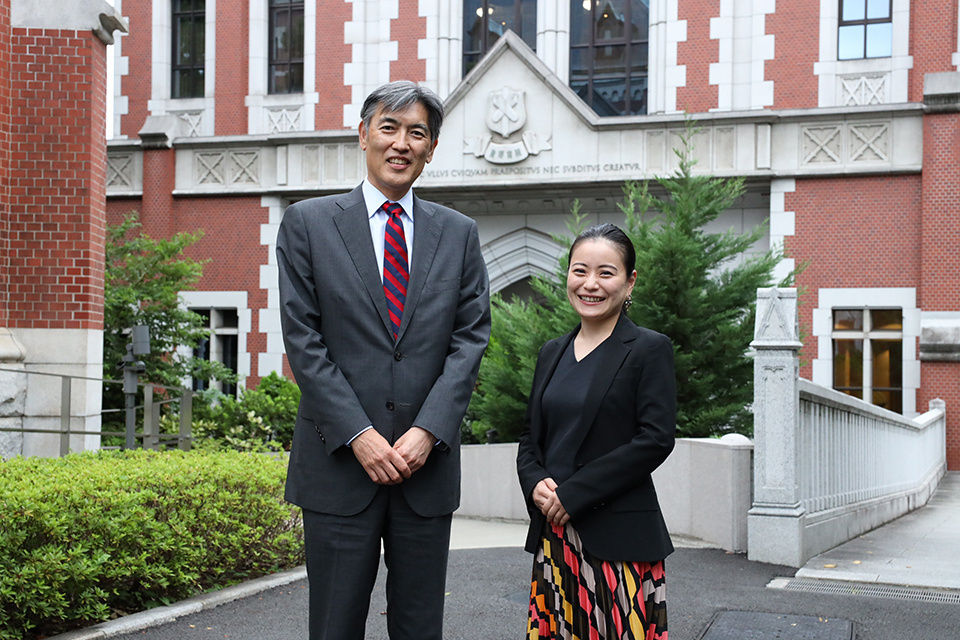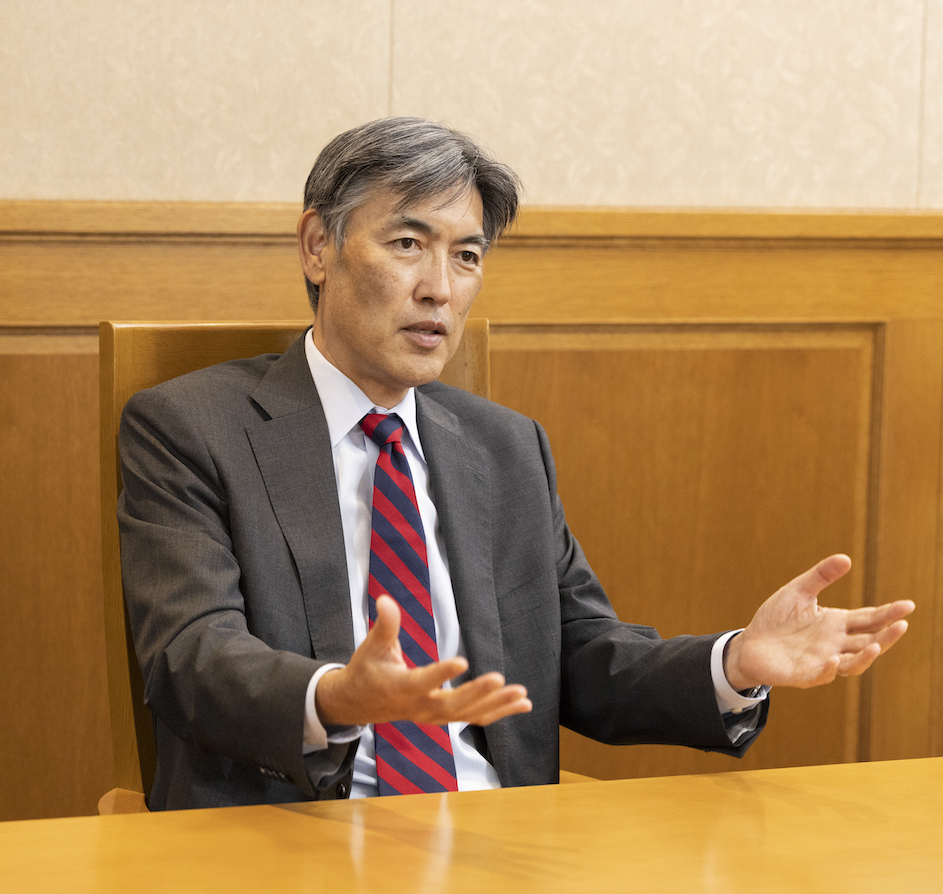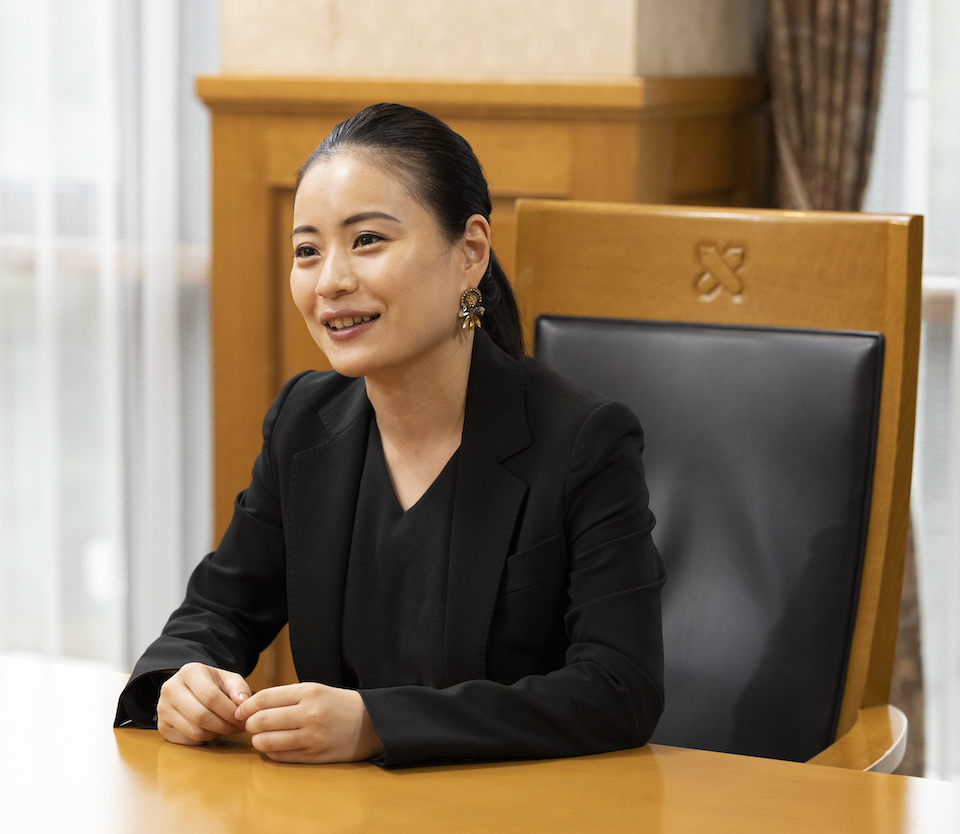To take a social agenda and convert it into an engine for growth, science, technology, and innovation are indispensable. Japan plans to develop research universities capable of meeting the highest global standards by establishing the 10-trillion-yen scale University Endowment Fund, which will dramatically enhance the research power of those universities. In this article, ITOH Kohei, President of Keio University, one of Japan’s top private schools, and HIRANO Miku, the promising young CEO of an AI startup, Cinnamon, Inc., discuss what it takes to be counted as a world-class research university.

ITOH Kohei, President of Keio University (left) and HIRANO Miku, CEO of Cinnamon, Inc
Generating innovation through science and technology is one of the key pillars of the Kishida administration’s growth strategy. As the race to attract outstanding human resources escalates among nations, the Japanese government has announced the creation of the 10-trillion-yen (approximately 70 billion dollars) scale University Endowment Fund to support the building of world-class research universities. Universities deemed capable of achieving research of the highest international standards will be designated as universities for research excellence and allocated a share of the fund’s profits. That will dramatically strengthen the research power of those institutions by providing long-term and stable financial support. The fund will additionally boost support for universities that have strengths in specific fields, as well as support for regional universities that play a central role in their localities and doctoral students of high ability. It will also assist in creating hubs for research centers and startup businesses, with the overall goal of placing Japanese universities at the head of intellectual competition.
This article presents the ideas of ITOH Kohei, a specialist in quantum computers who currently serves as president of Keio University, a top-tier private institution, and HIRANO Miku, CEO and founder of Cinnamon, Inc., a startup that delivers AI solutions. Hirano is also a selected member of the Forum of Young Global Leaders 2022, organized by the World Economic Forum (WEF). The two discuss the role of higher education and the prerequisites for a research university to lead the future.
What are your thoughts on the raison d’être of institutions of higher learning?
Hirano: I think that they are places where people are trained to create the future. I studied computer science and artificial intelligence (AI) all through college and graduate school, and that is how I came to believe that AI technology would change the world, and is also why I launched a startup as a first-year graduate student. I received help from venture capital awarded to university-based startups, so you could say that an institution of higher learning provided me not only with an academic education, but also with financial resources.
Itoh: It has been 150 years since the publication of Gakumon no Susume (An Encouragement of Learning), which was written by FUKUZAWA Yukichi, Keio’s founder, with the first edition co-authored by OBATA Tokujiro, former president of the school. It is a book that stresses the importance of education for social development. The content of education has evolved since then to include strategies to deal with global warming, for example, but the role of the university has not changed at all. It is still a place to learn how to improve society for the next hundred or two hundred years.

“My greatest hope is that universities chosen to benefit from the fund will explore new waters.”
ITOH KOHEI
President, Keio University
President of Keio University since May 2021. Awarded a B.E. in Instrumentation Engineering at the Faculty of Science and Technology, Keio University, in 1989 and an M.S. and a Ph.D. in Material Science & Engineering at the University of California, Berkeley, in 1992 and 1994, respectively. Field of specialization: quantum computers. American Physical Society fellow since 2021. Belongs to the Cabinet Office Council for Innovation in Quantum Technology.
Japanese universities are said to be less competitive in the global field than they once were. What are the reasons for that? The government has decided to establish a 10-trillion-yen scale University Endowment Fund to support world-class research universities. What are the merits of such a fund for universities?
Itoh: Japanese universities have not been innovative enough with regard to financial management and have not taken enough action to create the future. At the same time, it is clear that Japanese college tuition is generally lower than in other countries. In the United States, the annual tuition at famous private universities stands at about 60,000 dollars, more than 16 times costlier than that of national universities in Japan, which charge their students only 530,000 yen (approximately 3,670 dollars at 144 yen per dollar) per annum. At Keio University, which is private, the annual tuition for an undergraduate science major is about 1.7 million yen, equal to just 11,800 dollars. To attract the best students, we need to also attract the best teachers, but Japanese universities do not have sufficient funds for that. I have spoken with college presidents in Europe, where almost all universities are nationally funded, and they tell me that they have never had to worry about finance. To be able to compete with such institutions, I think it is a good thing for the Japanese government to be injecting money into universities on a competitive basis, even if a condition is attached to the university fund that it must maintain a profit margin of at least 3%.
Hirano: I, personally, could not have launched a business as a graduate student without having been selected for a program spearheaded by the Ministry of Economy, Trade and Industry (METI) to encourage the development of human resources in the IT field. So, I have high expectations for governmental support of this kind, including this fund.
Itoh: My greatest hope is that universities chosen to benefit from the fund will explore new waters. If a new framework were established where exceptional faculty members could receive higher pay, for example, I think it might be a good practice worthy of emulation by other Japanese universities.

“Japanese startups will evolve into an open-innovation ecosystem slightly different from that of other countries.”
HIRANO MIKU
CEO, Cinnamon, Inc
Serial entrepreneur. Awarded an M.Sc. from the University of Tokyo. Founded Naked Technology, Inc., while a graduate student. Following the sale of the firm to mixi. Inc., founded Cinnamon, Inc. Selected World Economic Forum’s member of the Forum of Young Global Leaders (YGL) 2022 class. Appointed as a member of the Council of New Form of Capitalism Realization, chaired by Prime Minister Kishida. A mother of three children.
Recent years have seen an increase in university-launched startups. What is behind that trend?
Hirano: At the global level, IoT (the Internet of Things), robotics and storage batteries are fields expected to grow economically at a rate of 30% per year. Spearheading cutting-edge fields such as those is exactly what startups are good at. I think the environment for Japanese startups will evolve into an open-innovation ecosystem slightly different from that of other countries. In Japan, major corporations play an immense role, backed by financial power and social trust. Cinnamon, the company I founded, was chosen to be part of a NEDO (New Energy and Industrial Technology Development Organization) program that supports university-based startups, and that has allowed me to develop my business in collaboration with big companies. While universities conduct the basic research, startups give the first boost to new technologies and also collaborate with major corporations implementing those technologies across society. This is the kind of collaboration we need to generate more innovation.
Itoh: I sense a change of atmosphere on campus concerning startups. Thanks to role-model business leaders like Ms. Hirano, students are not as averse to risk as they once were. Startup communities are being built, which act as safety nets for when things don’t work out. Faculty attitudes are also changing, so if students express a desire to do something practical with the technology they have on hand, they may be encouraged by their supervisor to launch a startup instead of being told that a student’s top priority is to write a research paper.
Although unrelated to startups, there has also been more collaboration such as that mentioned by Ms. Hirano. In my own field, which is quantum computers, researchers at our university have been reaching across disciplinary boundaries to improve computer systems as a whole. If that kind of collaboration is expanded to the international level, it will become a global effort.
Hirano: Back when I was a research student, it seemed to me that labs were very self-contained, with no opportunities whatsoever to share ideas with researchers in other fields or disciplines.
Itoh: The Cabinet Office currently assumes a central role in providing governmental subsidies for collaborative interdisciplinary projects. I think that people are learning to think more cooperatively by applying for such projects.
The government is also promoting the Vision for a Digital Garden City Nation, which aims to revitalize rural areas through digital technology, including the establishment of digital infrastructure. What are your thoughts on the role of universities in revitalizing the rural areas of the country?
Itoh: Keio University has already established the Institute for Advanced Biosciences in the city of Tsuruoka in Yamagata Prefecture in northern Japan. Global startups, such as a biotech firm called Spiber Inc., have been launched at the Institute, and it is local support that makes that possible. Above all, it is important for there to be support from the community and society. It is very encouraging when an entire city stands behind the university. We utilized our cutting-edge technology and collaborated with a local brewery to develop a new brand of sake, and we have participated in other efforts to boost regional development. When I visited Leiden University in the Netherlands, many local residents told me that the university has been the pride of the city since its founding four and a half centuries ago. I believe that it is very important for regional universities to work together with local residents to give more life to regions and to attract young people. In that respect, I believe that the 10-trillion-yen scale University Endowment Fund represents strong backing by the government.
What do you hope to see in Japanese research universities to make them globally competitive?
Hirano: Personally, it was only after the age of 30 that I began to think of myself as working for society as a whole. Today, I consider it my mission to create a better world for my children and grandchildren and for their children as well, and for generations living in a hundred and perhaps three hundred years into the future. If the universities that educate Japan’s future leaders cultivate high aspirations in their students at an early stage, I am sure that we can create a wonderful world.
Itoh: There is no doubt that universities must be more aggressive in pursuing the means to build a better society. There is much talk about the downturn in Japan’s competitive power, but if we consider the story of the tortoise and the hare, I think perhaps the tortoise may be a good role model for Japan. One sure step at a time will surely bring us to our goal. We—universities, the private sector, and the government in concert—will work, Japanese-style, to make a better world.






























